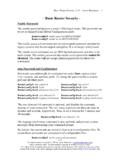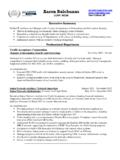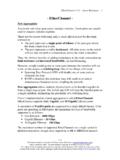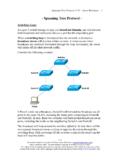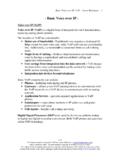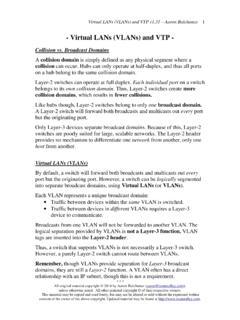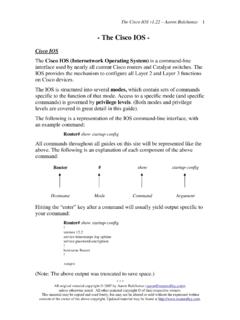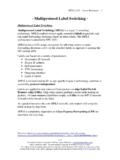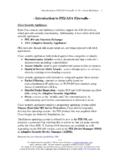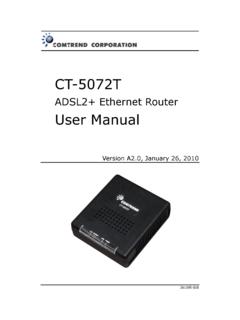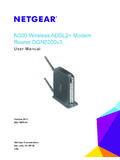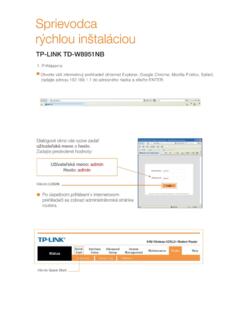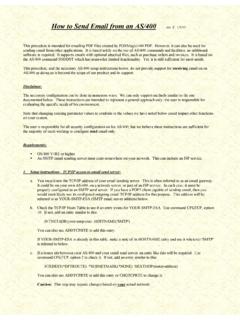Transcription of Border Gateway Protocol
1 BGP Aaron Balchunas * * * All original material copyright 2007 by Aaron Balchunas unless otherwise noted. All other material copyright of their respective owners. This material may be copied and used freely, but may not be altered or sold without the expressed written consent of the owner of the above copyright. Updated material may be found at 1 - Border Gateway Protocol - Border Gateway Protocol (BGP) BGP is a standardized exterior Gateway Protocol (EGP), as opposed to RIP, OSPF, and EIGRP which are interior Gateway protocols (IGP s). BGP Version 4 (BGPv4) is the current standard deployment. BGP is considered a Path Vector routing Protocol . BGP was not built to route within an Autonomous System (AS), but rather to route between AS s.
2 BGP maintains a separate routing table based on shortest AS Path and various other attributes, as opposed to IGP metrics like distance or cost. BGP is the routing Protocol of choice on the Internet. Essentially, the Internet is a collection of interconnected Autonomous Systems. BGP Autonomous Systems are assigned an Autonomous System Number (ASN), which is a 16-bit number ranging from 1 65535. A specific subset of this range, 64512 65535, has been reserved for private (or internal) use. BGP utilizes TCP for reliable transfer of its packets, on port 179. When to Use BGP Contrary to popular opinion, BGP is not a necessity when multiple connections to the Internet are required. Fault tolerance or redundancy of outbound traffic can easily be handled by an IGP, such as OSPF or EIGRP.
3 BGP is also completely unnecessary if there is only one connection to an external AS (such as the Internet). There are over 100,000 routes on the Internet, and interior routers should not be needlessly burdened. BGP should be used under the following circumstances: Multiple connections exist to external AS s (such as the Internet) via different providers. Multiple connections exist to external AS s through the same provider, but connect via a separate CO or routing policy. The existing routing equipment can handle the additional demands. BGP s true benefit is in controlling how traffic enters the local AS, rather than how traffic exits it. BGP Aaron Balchunas * * * All original material copyright 2007 by Aaron Balchunas unless otherwise noted.
4 All other material copyright of their respective owners. This material may be copied and used freely, but may not be altered or sold without the expressed written consent of the owner of the above copyright. Updated material may be found at 2 BGP Peers (Neighbors) For BGP to function, BGP routers (called speakers) must form neighbor relationships (called peers). There are two types of BGP neighbor relationships: iBGP Peers BGP neighbors within the same autonomous system. eBGP Peers BGP neighbors connecting separate autonomous systems. Note: Do not confuse an IGP, such as OSPF, with iBGP! In the above figure, RouterB and RouterC in AS 200 would form an iBGP peer relationship.
5 RouterA in AS 100 and RouterB in AS 200 would form an eBGP peering. Once BGP peers form a neighbor relationship, they share their full routing table. Afterwards, only changes to the routing table are forwarded to peers. By default, BGP assumes that eBGP peers are a maximum of one hop away. This restriction can be bypassed using the ebgp-multihop option with the neighbor command (demonstrated later in this guide). iBGP peers do not have a hop restriction, and are dependent on the underlying IGP of the AS to connect peers together. By default, all iBGP peers must be fully meshed within the Autonomous System. A Cisco router running BGP can belong to only one AS. The IOS will only allow one BGP process to run on a router.
6 The Administrative Distance for routes learned outside the Autonomous System (eBGP routes) is 20, while the AD for iBGP and locally-originated routes is 200. BGP Aaron Balchunas * * * All original material copyright 2007 by Aaron Balchunas unless otherwise noted. All other material copyright of their respective owners. This material may be copied and used freely, but may not be altered or sold without the expressed written consent of the owner of the above copyright. Updated material may be found at 3 BGP Peers Messages BGP forms its peer relationships through a series of messages. First, an OPEN message is sent between peers to initiate the session. The OPEN message contains several parameters: BGP Version must be the same between BGP peers Local AS Number BGP Router ID KEEPALIVE messages are sent periodically (every 60 seconds by default) to ensure that the remote peer is still available.
7 If a router does not receive a KEEPALIVE from a peer for a Hold-time period (by default, 180 seconds), the router declares that peer dead. UPDATE messages are used to exchange routes between peers. Finally, NOTIFICATION messages are sent when there is a fatal error condition. If a NOTIFICATION message is sent, the BGP peer session is torn down and reset. As a BGP peer session is forming, it will pass through several states. This process is known as the BGP Finite-State Machine (FSM): Idle the initial BGP state Connect - BGP waits for a TCP connection with the remote peer. If successful, an OPEN message is sent. If unsuccessful, the session is placed in an Active state. Active BGP attempts to initiate a TCP connection with the remote peer.
8 If successful, an OPEN message is sent. If unsuccessful, BGP will wait for a ConnectRetry timer to expire, and place the session back in a Connect State. OpenSent BGP has both established the TCP connection and sent an OPEN Message, and is awaiting a reply OPEN Message. Once it receives a reply OPEN Message, the BGP peer will send a KEEPALIVE message. OpenConfirm BGP listens for a reply KEEPALIVE message. Established the BGP peer session is fully established. UPDATE messages containing routing information will now be sent. If a peer session is stuck in an Active state, potential problems can include: no IP connectivity (no route to host), an incorrect neighbor statement, or an access-list filtering TCP port 179.
9 BGP Aaron Balchunas * * * All original material copyright 2007 by Aaron Balchunas unless otherwise noted. All other material copyright of their respective owners. This material may be copied and used freely, but may not be altered or sold without the expressed written consent of the owner of the above copyright. Updated material may be found at 4 Configuring BGP Neighbors The first step in configuring BGP is to enable the BGP process, and specify the router s Autonomous System (AS): RouterB(config)# router bgp 100 RouterB is now a member of AS 100. Next, neighbor relationships must be established. To configure a neighbor relationship with a router in the same AS (iBGP Peer): RouterB(config)# router bgp 100 RouterB(config-router)# neighbor remote-as 100 To configure a neighbor relationship with a router in a separate AS (eBGP Peer): RouterB(config)# router bgp 100 RouterB(config-router)# neighbor remote-as 900 Notice that the syntax is the same, and that the remote-as argument is always used, regardless if the peering is iBGP or eBGP.
10 For stability purposes, the source interface used to generate updates to a particular neighbor can be specified: RouterB(config)# router bgp 100 RouterB(config-router)# neighbor update-source lo0 RouterC must then point to RouterB s loopback (assume the address is ) in its neighbor statement: RouterC(config)# router bgp 900 RouterC(config-router)# neighbor remote-as 100 RouterC must have a route to RouterB s loopback in its routing table. BGP Aaron Balchunas * * * All original material copyright 2007 by Aaron Balchunas unless otherwise noted. All other material copyright of their respective owners. This material may be copied and used freely, but may not be altered or sold without the expressed written consent of the owner of the above copyright.
